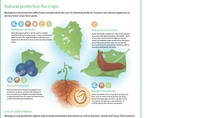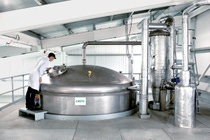News & Media
Tiny worms slay slugs and snails
Biological crop protection complements chemical methods
- Natural helpers
BASF uses a variety of living organisms for targeted pest control - Effective combination
Biological and chemical crop protection for fruit and vegetable farming - Intensive research
A new center with strain library and research labs for the solutions of tomorrow
As anyone with a garden knows, a single wet night is enough to unleash a plague of slugs. A couple of hours of darkness is all the mollusks need to munch their way through all your vegetables and flowers, causing a huge amount of damage. The aftermath of their nocturnal activities is all too apparent the next morning – too late though to do anything about it.

As annoying as this may be for hobby gardeners, it can be devastating for farmers. Understandably, they would do almost anything to keep slugs and snails off their land. In addition to an array of chemical pest control agents, they can choose a fully biological solution: nematodes.
These tiny worms are a remarkably diverse species, with up to 20,000 different strains described to date. Some attack crops and are pests in their own right, but others have an attribute that can be harnessed for good: they burrow their way into insects and snails and put a stop to their greedy antics.
Effective natural support
Nematodes are therefore used alongside useful bacteria, viruses, insects and plant extracts for biological pest control. The basic idea: Harmless organisms kill or displace crop pests such as locusts, harmful insects, bacteria, molds and slugs that cause diseases and threaten harvests. Although these natural helpers can never fully replace chemical agents, biological pest control provides effective support. Vegetable and fruit farmers particularly appreciate their effects shortly before harvesting, as they protect the crops and fruits without leaving any chemical residues behind.
"Biological pesticides are effective in combating low to moderate levels of infestation," said Burghard Liebmann, group leader biological crop protection at BASF research. "In most cases, however, the level of infestation and pest exposure is so high that a combination of chemical and biological agents is necessary to provide effective control." Precisely therein lies BASF's strength: "With our very broad product spectrum, we can offer an individual and flexible solution tailored to meet the particular problem and local conditions. This is also a very important consideration in counteracting and preventing insect pests and plant pathogenic fungi from becoming resistant to certain chemical crop protection agents," Liebmann pointed out.
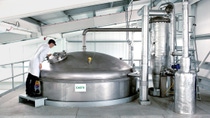
BASF is a world leader in biological pest control. In April 2016, the company launched a brand new research and development center for biological crop protection and seed solutions at the headquarter of the Crop Protection division in Limburgerhof near Ludwigshafen, Germany. The new center is the hub of BASF's global network of research and development sites and test centers for biological crop protection and seed solutions, with facilities in Brazil, France, China, the United States and Canada.
Targeted culturing breeds helpful organisms
BASF's portfolio already contains biological crop protection products to combat all sorts of plant pathogenic fungi, insects and slugs that cause problems in agriculture and horticulture. The process leading to the production of a biological pest control agent always begins in nature. Researchers identify and isolate natural microorganisms from soil samples or plants, and collect them in a microorganism strain library. BASF has its own strain library which houses thousands of microorganisms awaiting their potential mission. When scientists want to develop a new biological crop protection product, they will look here to find exactly the right organism for the job, for example, to fight a certain fungus or insect pest. Once it has been identified, the real work begins: Sufficient amounts of this organism need to be grown in equipment called fermenters. The creatures can be quite picky, too: "Nutrients, temperature, oxygen levels – all impact their well-being and ability to reproduce," the biologist revealed.
To ensure survival, storability and ease of use for farmers, the microorganisms are formulated and turned into a product with good performance properties. Again, specialist expertise is called for. "The microorganisms must be transformed into a kind of resting state but without letting them dry out and die. And since every organism reacts differently to environmental influences, it takes a lot of experience and know-how to develop a good product," Liebmann said. The result is a powder or liquid product that farmers dissolve in water or dilute before spraying them on crops or soil.
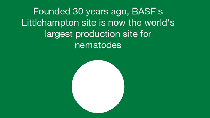
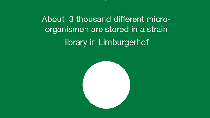
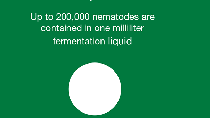
If slugs are the foe, Nemaslug® is a good choice – a mulluscicidal powder containing nematodes of the species Phasmarhabditis hermaphrodita. When the nematodes encounter a slug, they burrow into its body through their breathing orifice. The slug loses its appetite within two days and dies in about a week.
Simple principles, originating in nature and highly effective: this is what makes biological pest control so very interesting. "We plan to explore a lot more new applications for biological crop protection in the future." One example is using beneficial nematodes to protect citrus trees. BASF is now launching Nemasys® R in Florida. Nematodes of the species Steinernemariobravae contained in the product attack beetle larvae that burrow their way into the roots of citrus trees and threaten the livelihoods of Florida's orange growers. Liebmann is confident: "We have not yet reached the end of our options in biological crop protection. Not by a long shot."
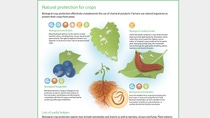
Nematodes protect citrus trees

An interview with Professor Larry Duncan, an expert on biological protection of citrus plants at the University of Florida.
Professor Duncan, you work in the field of biological crop protection. Why do we need this?
The vast majority of potential pests in the tree canopy are under biological control by their natural enemies of the pests. Those interactions are quite well understood and many tactics have been developed to foster biological control of aboveground pests. However, we cannot yet exploit the services of naturally occurring biological control agents in soil because little is known about soil food webs. As we learn what organisms prey on pests in soil, and what affects those natural interactions, we are discovering ways to modify the complex belowground habitat in ways that conserve or enhance biological control by naturally occurring or introduced biocontrol agents.
Your main research area is citrus diseases. What are the challenges?
My research interests include a species of weevil called Diaprepes abbreviatus. The beetles feed on young leaves and lay their eggs there. The larvae drop to the soil surface, feed on roots, and pupate in the ground. Larval feeding is very damaging to the tree and plant pathogenic fungi also invade the wounds. After pupation, adult weevils emerge from the soil to mate and lay eggs. In orchards with heavy infestation, the trees are dead in a year or two. The problem became acute in 2005 when the citrus disease “huanglongbing” made its way to Florida and further damaged the tree root system.
What can be done about them?
It's always hard to interrupt the life cycle between leaf and ground with a pesticide that only stays active on the leaves for a short time. And there are no approved pesticides that we can use for effective control of the larvae in the ground. In our research into biological ways of bringing Diaprepes abbreviatus under control, we realized that insect-killing nematodes like Steinernema riobrave are hugely promising. They attack the beetle larvae and in combination with adult management, help reduce the weevil population density to less damaging levels.
Crop proptection agents in agriculture
Crop protection agents protect plants from pests, diseases and weeds. They can be divided into chemical and biological crop protection agents. For conventional farming, synthetic crop protection agents can be used according to the specification of the so called “best practices”. In distinction from this, ecological farming follows the legal obligation to refrain from using chemical crop protection agents. Farmers can draw on a strictly limited selection of crop protection agents which occur in nature. Biological crop protection agents can be used in conventional as well as ecological farming. BASF offers various biological control agents against about 20 different diseases and pests. For example, the biological fungicide Serifel®, based on Bacillus amyloliquefaciens, provides broad-spectrum fungal disease control and can for example be used against gray mold, powdery mildew and white mold. Velifer® helps against whiteflies, thrips, mites and several other insects. And Nemaslug® provides control for a wide range of slug species.
Further information on biological crop protection of BASF: www.agriculture.basf.com

